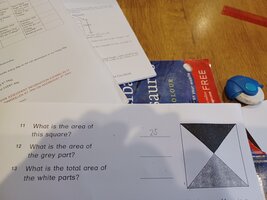LiseyDot05
New member
- Joined
- May 3, 2023
- Messages
- 35
Hi everyone. I'm new to this forum but I'm hoping this will be my saviour when I'm sat scratching my head.
My wee son is stuck on this math problem. The square measures 5cm by 5cm. He has the area worked out to be 25cm (he realises it should say 25cm². It is the other 2 questions that he is stuck on & ashamedly, I'm not sure how to explain it to him.

My wee son is stuck on this math problem. The square measures 5cm by 5cm. He has the area worked out to be 25cm (he realises it should say 25cm². It is the other 2 questions that he is stuck on & ashamedly, I'm not sure how to explain it to him.

